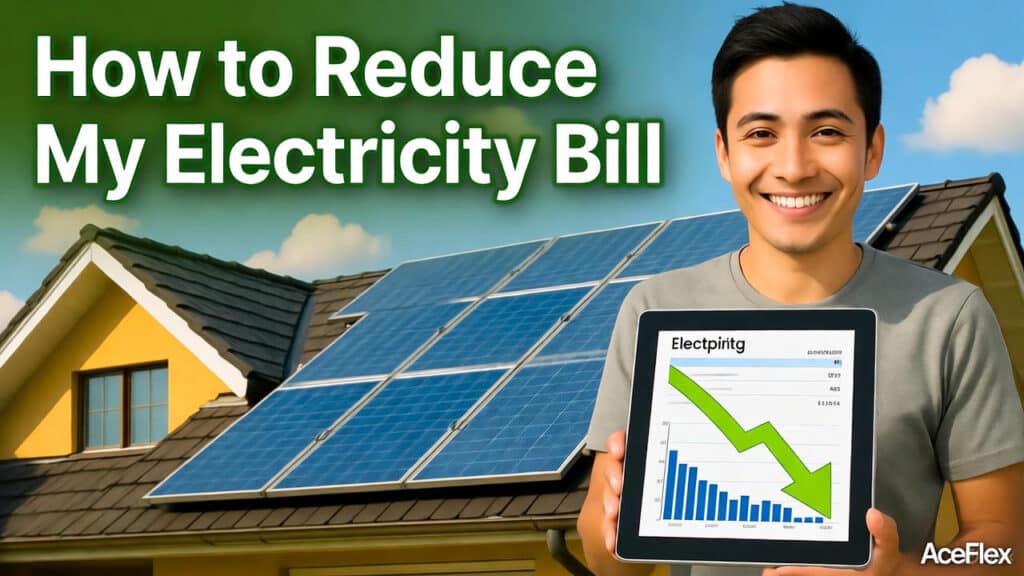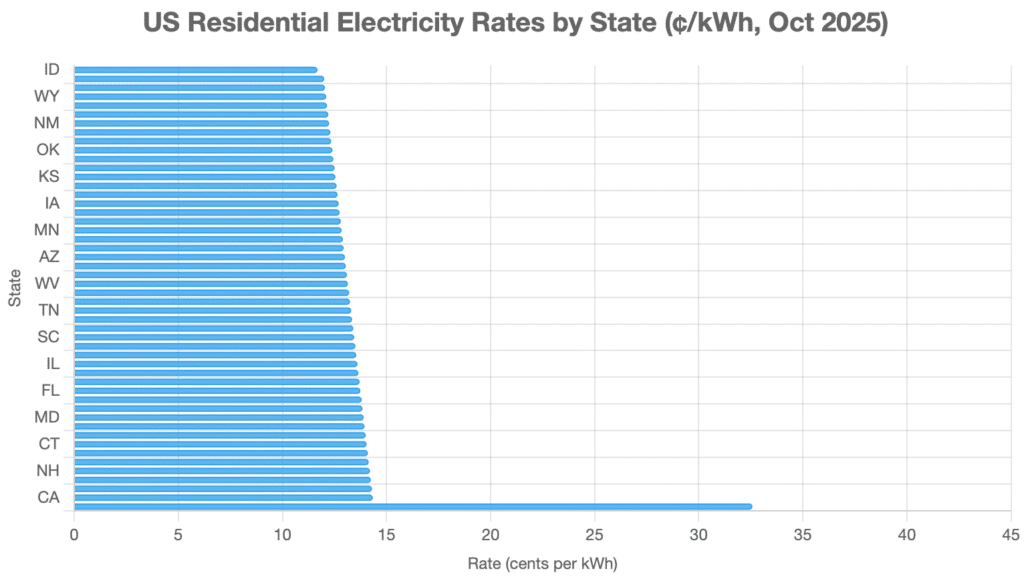📦 Fast Delivery – Order Now!
💸 Shop Safely – 100% Money-Back Guarantee
👨🔧 Lifetime Customer Support
📦 Fast Delivery – Order Now!
💸 Shop Safely – 100% Money-Back Guarantee
👨🔧 Lifetime Customer Support
Are you dreading the moment you open your electricity bill, only to see it climb higher each month? You’re not alone—millions of US homeowners are searching for answers to the question, how to reduce my electricity bill, especially with energy costs on the rise. In 2025, the average household spends over $1,500 annually on electricity, and those costs can sting, whether you’re battling summer heatwaves in Texas or keeping warm in a chilly Northeast winter.
The good news? You can take control of your energy expenses with practical, money-saving strategies that work. From simple changes like swapping out old lightbulbs to game-changing investments like solar panels, this guide covers proven ways to lower your bill and boost your home’s efficiency. At AceFlex, your trusted solar online shop in the US, we’re here to help you slash costs and embrace sustainable energy solutions. Ready to start saving? Let’s dive into how to reduce your electricity bill today!

Before you can tackle high energy costs, it’s crucial to understand what’s driving them. Your electricity bill is more than just a number—it’s a breakdown of fixed charges, usage rates (measured in kilowatt-hours or kWh), and sometimes peak or off-peak pricing depending on your utility. For example, states like California often have higher rates (around 25¢/kWh) compared to the Midwest (closer to 15¢/kWh), which directly impacts your bottom line. Start by auditing your bill to spot patterns, like spikes during heavy AC or heating months. Many US utilities offer free apps or online tools to track your usage in real-time, giving you a clear picture of where your dollars are going. Armed with this knowledge, you’re ready to explore actionable strategies to answer the question, how to reduce my electricity bill, starting with easy changes that deliver quick wins.
To visualize the costs of energy in the US, we’ve created a bar chart showing the average residential electricity rates (in cents per kWh) across all 50 states, based on the latest data from the U.S. Energy Information Administration (EIA) as reported in October 2025. Rates range from a low of 11.69¢/kWh in Idaho to a high of 42.49¢/kWh in Hawaii, with a national average of approximately 17.47¢/kWh. This highlights regional variations driven by factors like energy sources, regulations, and geography.

Source: EIA Electricity Data
Want to know how to reduce my electricity bill without spending a fortune? You can start saving today with simple habits that pack a punch. Across the US, from sunny Arizona to snowy Michigan, small changes to your daily routine can shave dollars off your bill—sometimes hundreds annually! These no-cost or low-cost tips are perfect for renters, homeowners, or anyone looking to cut energy costs fast. Below, we’ve listed our favorite ways to lower your electricity use, with real savings estimates based on average US rates (17.47¢/kWh in 2025). For even bigger wins, explore solar solutions at [Your Shop Name], where our panels and kits can help you generate your own power and slash bills for good. Let’s get started!
While small habits like switching to LEDs or unplugging devices can save you $50–$150 a year, going solar is the ultimate answer to how to reduce my electricity bill with jaw-dropping results. Solar panels harness sunlight to generate free electricity, cutting your grid reliance by 50–100% and saving $1,000–$2,000 annually for the average US home (based on 17.47¢/kWh in 2025). In high-cost states like California (32.58¢/kWh) or Hawaii (42.49¢/kWh), savings can be even higher! The upfront cost—typically $10,000–$20,000 for a 5–10 kW system—might seem intimidating, but federal tax credits (30% through 2032), state rebates (like California’s SGIP or New York’s NY-Sun), and net metering programs make it affordable.
Many homeowners also opt for low-interest solar loans or leases, reducing out-of-pocket costs to nearly zero. Most systems pay for themselves in 6–10 years, then deliver decades of near-free power. Plus, solar boosts your home’s value and shrinks your carbon footprint. At AceFlex, we offer top-rated solar panels, inverters, and DIY kits tailored for US homes. Use our online savings calculator at the end of this post to see your potential savings and explore financing options. Ready to make the leap? Visit AceFlex today and start slashing your electricity bill with solar power!

You’re already armed with strategies for how to reduce my electricity bill, from daily habits to solar power, but a few extra tips and cautionary notes can ensure you maximize savings. Whether you’re in a high-cost state like California or a more affordable one like Idaho, these practical steps and pitfalls to avoid will keep your energy costs in check. The following advice, based on 2025 US energy trends, helps you stay proactive and avoid costly missteps. Here’s what to do—and what not to do—to keep your electricity bill low.
ou’ve now got a toolbox full of proven strategies to answer how to reduce my electricity bill—from simple habits like switching to LEDs to game-changing solar power. Whether you’re cutting costs with smart thermostats in chilly Minnesota or harnessing sunlight in sunny Arizona, these tips can save you hundreds annually while reducing your environmental impact.
The biggest win? Going solar with panels from AceFlex, which can slash your bill by $1,000–$2,000 a year and pay off in just 6–10 years. Ready to take control of your energy costs? Visit [Your Shop Name] to explore our high-efficiency solar panels, DIY kits, and inverters tailored for US homes. What’s your favorite tip for how to reduce my electricity bill? Share in the comments below, and check out our other guides, like “What Is a Inverter and Why Does It Matter for Your Solar System?” for more ways to go green and save big!

Saving 90% of your electric bill requires efficiency upgrades (e.g., ENERGY STAR appliances, insulation) and a well-sized solar system (5–10 kW), offsetting 90%+ of grid use with net metering and a 30% federal tax credit. AceFlex offers solar kits—use our calculator to estimate savings.
Heating and cooling (48%) and water heating (18%) are the top culprits, per EIA data, followed by refrigerators (7%) and lighting (6%). Use programmable thermostats and solar from AceFlex to target these.
Unplug “vampire” devices (e.g., chargers) with a power strip to save $50–$100/year, and wash with cold water for 90% energy savings. Boost it with AceFlex solar panels for bigger cuts.
Florida’s average monthly bill is $160 (1,100–1,800 kWh at 14–15¢/kWh), per EIA, ranging $120–$280 by region. Solar from AceFlex can lower this with net metering and tax credits.
Heating/cooling (48%), water heating (18%), and refrigerators (7%) lead, per EIA. Seal drafts, use cold water, and install AceFlex solar panels to offset these.
A 50–100W LED TV costs $0.21–$0.42/day ($77–$153/year) at 17¢/kWh, or $15–$33 for 5 hours/day. Unplug when off; use AceFlex solar to power it free.
Yes, standby power (0.5–2W) adds $1–$5/year. Unplug it or use a power strip. AceFlex solar eliminates this with off-grid options.
A 1–2 kWh wash costs $0.20–$0.50 at 17¢/kWh, or $3–$10/month for 5–7 loads. Use cold water and AceFlex solar to cut this to zero.
Yes, off-peak rates (10 PM–6 AM) save 20–50% ($0.05–$0.20/cycle) in states like California. Pair with AceFlex solar batteries for free overnight power.
A fridge costs $3–$13/month ($36–$160/year) at 17¢/kWh, depending on size. Optimize placement and use AceFlex solar to power it free.
Yes, cold water saves 90% of a washer’s energy ($50–$100/year), per EPA. Use it for most loads, and pair with AceFlex solar for max savings.
Solar panels typically pay off in 6–10 years, depending on system cost ($10,000–$20,000), savings ($1,000–$2,000/year at 17¢/kWh), and incentives like the 30% tax credit.
Yes, DIY solar kits from AceFlex let you install panels yourself if you have basic skills and a suitable roof, saving on labor ($5,000–$10,000).
Yes, the federal 30% Investment Tax Credit (through 2032) and state rebates (e.g., California’s SGIP) cut solar costs significantly.
In winter, lower your thermostat to 68°F, seal drafts, and use LED lighting to save $100–$200/year, per EIA.
AceFlex is one of the leading online retailers of renewable energy products and offers a wide range of solar products. We work with well-known manufacturers and wholesalers and can offer you cost-effective products in the field of photovoltaics so that you too can contribute to the energy transition.
Looking for an experienced team for planning your photovoltaic system without the hassle of doing it yourself? We are your trusted partner, offering comprehensive nationwide solutions. We provide expert consultation and supply of both photovoltaic systems and storage units tailored to your specific needs.
© 2025 Aceflex All Rights Reserved. Design by Media Pantheon, Inc.